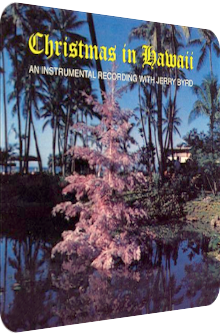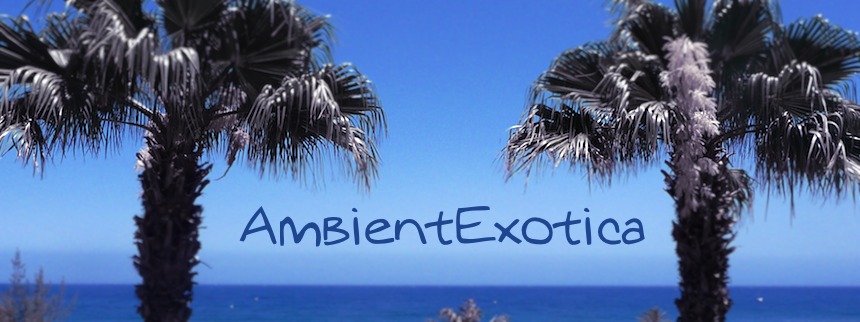
Jerry Byrd
Christmas In Hawaii
1987
What is to expect from a Christmas album? No, I’m being serious here: are the aesthetic values of such albums still intact considering the flood of releases which drift ashore every year? These questions do arise at certain points over the course of Christmas In Hawaii, one of steel lap guitarist Jerry Byrd’s (1920–2005) clear cut Hawaiian albums in his otherwise Country-focused discography. Heartwarmingly enough, Byrd’s point of origin was Hapa Haole music all along even though his Country albums outweigh his Hawaiian or Exotica releases by a wide margin.
Ten tracks full of steel guitars, ukuleles and vibraphones are featured on this album which was originally released in November 1987 on Lehua Records and is now thankfully available on CD, music cassette and digital download with even the stupid yellow Gothic font on the front artwork still evoking the Christmas spirits; oh my! I am reviewing the presumably remastered re-issue of 2003. And for the record, I do not want to overanalyze the theme of this album. It is a Christmas album, and that’s about it. Right? Sure, although every Christmas album that comes with an interesting twist or gimmick – in this case: the Hawaiianization of traditional material – is torn between different expectations.
Does Jerry Byrd want to present altered versions at all costs, or is he sometimes keen on staying close to the traditional side? I hesitate to give the answer right now, and I believe the answer itself is not that important. There is undoubtedly a stylistic dichotomy on this album, for Christmas In Hawaii is on the one hand produced in order to transform the traditional treasury of songs into Hawaiian sun-fueled mutations and is on the other hand fond of interweaving uniquely Hawaiian material. The ensuing puzzlement is no flaw per se. The targeted group of this album is rather slim, as choral and ecclesial Christmas albums are still the norm, followed by the great selection offered by skilled entertainers and highly gifted singers such as Frank Sinatra, Peggy Lee, Bing Crosby or Tony Bennett. The instrumental Christmas In Hawaii still offers many a charming rendition, and who knows, maybe you are even fond of its strange setbacks and quirky fallacies in maintaining the promised mood.
Christmas Island marks the first stop of the album. Originally written by Lyle Moraine, this less-known tune has never entered the official canon of Christmas songs, but becomes oh so tropical and dreamy in the hands of Jerry Byrd. He plucks his wonky steel guitar in an unexpectedly Space Age-resembling way, its high tones conflate well with the liquedous acoustic guitar backings and prominent vibraphone snowflakes. Rest assured that there is not even a glimpse of a classic Christmas feeling evoked, but such is expected on a record like this. I am fond of this rendition for a different reason: Mr. Byrd maintains a refreshingly low profile! Sure enough is his lap steel guitar audible most of the time, but there are many segues in which the remaining instruments of the arrangement are equally important.
The auspiciously titled classic Winter Wonderland by Felix Bernard and Dick Smith is even sunnier and warmer, especially so since the theremin-resembling characteristic trait of the lap steel guitar is exchanged with a warmer polyphony. And let’s not forget the essential omission here, the chinking tambourins. Decades after Dean Martin and Pat Boone, the focus shifts away from the archetypical nostalgia. I do like the kitschy versions of this song, but am willed to praise the varying pattern of vibraphone glitz and steel guitar goodness as well. Christmas In Hawaii is offering even more traditional material in the form of What Child Is This, and boy, is this a dreamy mélange of steel guitar layers and a crunchy rhythm ukulele. The tempo schleps itself forward, the usually feasible melodrama is lessened by the ethereal warmth. It is slower songs like this which encapsulate the languorous beauty of the lap steel guitar. Alex Anderson’s Mele Kalikimaka (meaning Merry Christmas) is next and revs the tempo decidedly up. Oscillating between an acoustic guitar-accentuated Country concoction and a Hapa Haole halo, Byrd’s take delivers one particularly interesting inclusion, namely a fast-paced vibraphone melody which invokes the glacial Christmas feeling that is otherwise missing on this album.
It turns out that Mele Kalikimaka won’t be the last pick of Anderson’s back catalog, as the eponymous Christmas In Hawaii was originally written by him as well. The biggest treat of Byrd’s rendition is an unexpected Sicilian or Parisian harpsichord-like intermission that literally tears the ambiguously vibraphone-frosted warmth apart like a crevasse. While Ray Evan’s and Jay Livingston’s Silver Bells is tremendously Hawaiian due to the sun-soaked warped legato of the dreamy steel guitar and due to the missing link to that Christmas feeling which cannot even be resurrected by the blue tinge of the vibraphone dots, the melody of the hyper-traditional Silent Night is so well-known that the spectral steel guitar rivers and rhythmic ukuleles do in fact accomplish to inject a warm feeling into the hearts. It is here that the formula of the album wears dangerously thin, for this version resides in close proximity to the gazillions of other Silent Night takes. If the tempo was faster, the song could have departed from the melancholic nostalgia. But here, Jerry Byrd decides to stay close to the core for whatever reason.
Irving Berlin’s eternal masterpiece White Christmas follows next, and yep, the melody is perfectly carved out and played by both the vibraphone and Byrd’s dreamy steel guitar, and here the feeling perfectly fits, for if there is one place in the United States where people can only dream about a white Christmas, it is certainly Hawaii. The yearning, funnily enough, is hence boosted by the guitarscape. Away In A Manger follows and resembles the arrangement of Silent Night in that there is a downbeat ukulele rhythm and – less doleful, more sun-dried – strings of steel, thereby never letting the sun out of sight. The closer of the album is Blue Christmas, originally written by Bill Hayes and Jay Johnson, and in contrast to the intimacy of Away In A Manger, the mood is boosted to a bedazzling brightness, the Hawaiian Hapa Haole factor is as huge as the Country style is being absent. The steel guitar is covering all ranges, from crisp and vibrant to howling and transfiguring, and the vibes are better embedded in this version, remaining underpinning devices rather than being put in the limelight as it happened many times over the course of the album.
It may be seen as a sad state of affairs that I have written so much about a highly ephemeral Christmas album, but I felt the need to stress the point about its aforementioned dichotomy: Christmas In Hawaii functions in a twofold way, firstly in taking traditional material that everyone and their mother knows and has fond childhood memories of in order to alter it and morph it into a paradisiac sunshine panorama that lives up to the Hawaiian islands, and secondly in presenting less-known truly Hawaiian material to the devoted listener so that the whole family widens their music-related horizon. If it only were as easy as this. The target group remains a blur, the album is more of a prestigious project or give-away item rather than a work of art whose transformations persuade in terms of their witticism and inventive arrangements of otherwise well-known songs. If you are willed to peel these circumambient social factors outside of the work-related aesthetics off, it turns out that the emanating steel guitar-based nucleus nurtures a good Hapa Haole album whose additional vibraphones, acoustic guitars and rhythm ukuleles provide a resplendent soundscape which meshes and mingles with the blueprint of the listener’s childhood memories, depending of course on his or her background. The omission of triangles, tambourins, pathos and vocals really do offer a different listening experience.
The reason why I am fond of Jerry Byrd’s work is simply a matter of location: I am usually celebrating Christmas on sunny islands, and although these are not Hawaiian islands, it is their tropical vista, soft breezes and mild temperatures which do provide the pitch-perfect conditions for enjoying this album in the pre-Christmas period. I cannot picture myself listening to this album at freezing temperatures, but at the right place, it sure works. I for one am also glad that Byrd keeps the Country or Folk flavor low, there is only one tune or two where the chords resemble the saccharine schmaltz he is also known for, but regardless of these instances, Christmas In Hawaii is a good album. I would have wished for an album full of Hawaiian Christmas songs instead of this weird mix-up, but hey, the nostalgia layers keep on working, and I am not as critical of this album as I should be. Consider it my Christmas bonus for Jerry Byrd.
Exotica Review 160: Jerry Byrd – Christmas In Hawaii (1987). Originally published on Dec. 22, 2012 at AmbientExotica.com.
